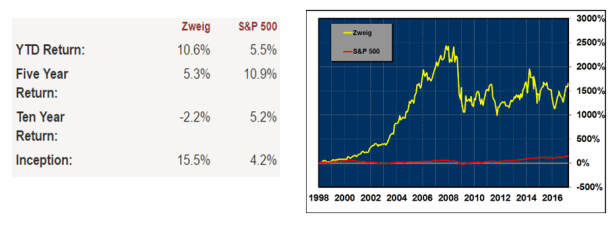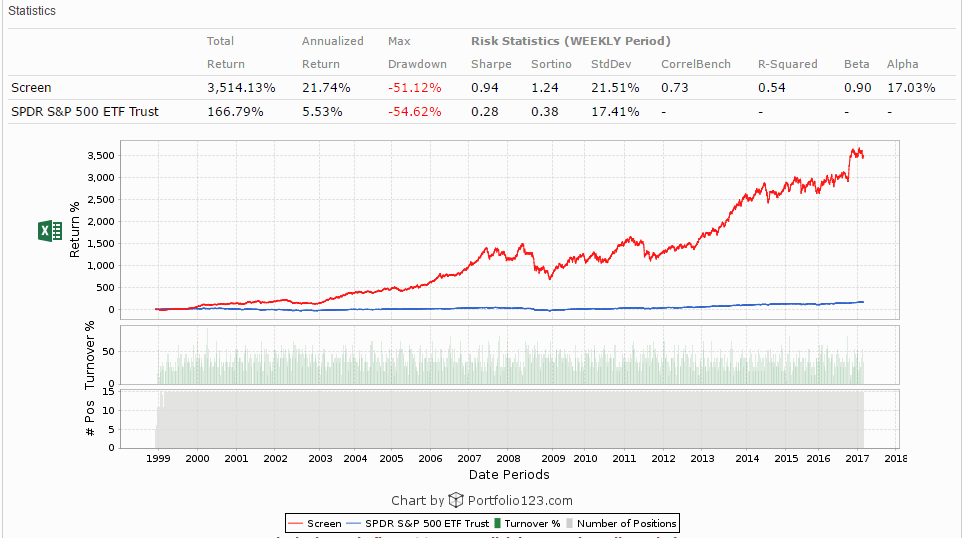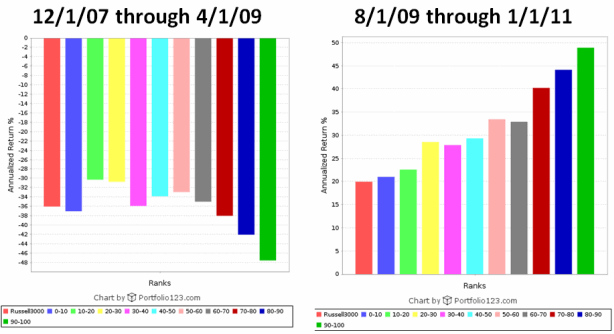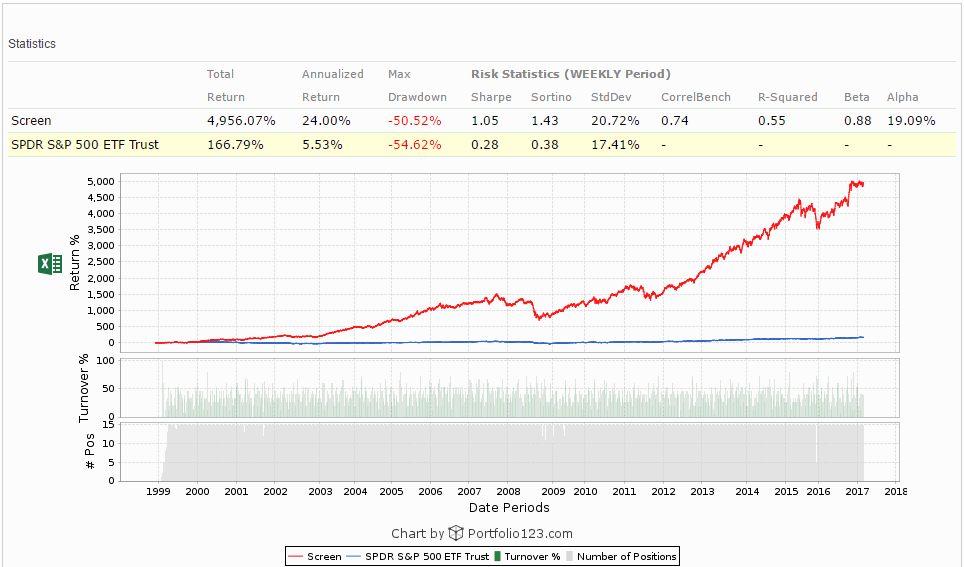Growth Stock Investing
While not as popular as value investing, growth stock investing has proponents and published successes. Two well known gurus, Louis Navellier and Martin Zweig, have published growth strategies with significant potential.
Growth stocks gets lots of bad press because they can be high risk. Once you examine the work of Louis Navellier, you will understand it does not need to be high risk.
Strategy Factors for Growth Stock Investing
Both Navellier and Zweig describe solid, low risk approaches to growth stock investing. The criteria identified by each is detailed below.
As always, gurus do not rely on just one class of criteria. These strategies include market data, sentiment, financial strength, value and quality criteria as well as criteria from their focus - growth.
Richard Tortoriello, in Quantitative Strategies for Achieving Alpha, took a close look at growth (earnings and sales) factors and their effect on stock performance. As a single factor, growth drives the day-to-day performance of a stock. In other words, if you look at the top performing stocks of the past year, they tend to be the companies with the strongest earnings and/or sales growth.
However, as a single factor, they are not predictive of future performance. Tortoriello suggests that the market is very efficient to growth and reacts immediately.
The good news?
Bundled together with other classes of criteria, past growth is predictive of future performance. And it does not need to involve high risk.
Martin Zweig
In the 1990 edition of his book, Winning on Wall Street, Martin Zweig spells out the screening process he used when all he had was newspapers.
Much nicer with stock screening tools.
Universe and screening factors
Only stocks with analyst coverage are included in the universe. A minimum liquidity must be specified, at least in terms of shares per day.
Zweig uses the following key factors to identify the best growth stocks:
- Insider buying is a plus but not a requirement. Exclude stocks with insider selling
- Earnings surprises - negative surprises should be avoided
- Sales growth - both quarter over quarter and year over year
- Sales growth acceleration
- Earnings growth - both quarter over quarter and year over year
- Earnings growth acceleration
- Reasonable PE ratio with respect to the universe PE ratio and the growth rate of the stock
- Exclude companies with excessive debt
- Strong price action by the stock
Notice that factors 1 & 2 are sentiment criteria, 3 thru 6 are growth criteria, 7 is a value criteria, 8 is financial strength, and 9 is market data.
Growth stock investing, not just growth factors.
Embedded in the screening criteria. are reasons to sell:
- Insider selling
- Negative earnings surprises
- Loss of growth or value
- Failing relative strength (price action)
For failing price action, Zweig recommended trailing stops. But, he provided on qualitative approach. Also, he used a multi-factor model to determine the condition of the market (aka market timing).
If his trailing stop approach or his market timing approach are of interest, it would be best to get a copy of his book. Check both the 1990 and 1997 editions.
Like Buffet, Dreman and Greenblatt, Zweig recommends that retail investors follow a shotgun approach - don't try to pick specific stocks through detailed analysis. Instead, buy a basket of stocks that meet the above criteria. In other words, use a quantitative approach. Zweig believes about 5/8 (62.5%) of your picks will be winners over time with a proven quantitative strategy.
A quantitative basket of stocks with a 60% win rate is a common theme in the published work of many gurus. Like Zweig, most recommend that you avoid qualitative analysis unless your are a trained financial analyst.
Baseline performance
Using Stock Investor Pro, AAII generated a model portfolio based on the published work of Martin Zweig. It does not include items 2 or 8, but is a baseline. The results were generated by running the screen each month and tracking the performance of the stocks passing the screen. Dividends are not included in the results.
On average, 10 stocks passed the monthly screen.
If you are an AAII member, you can view their interpretation of Zwieg's growth strategy. Even if you are not, you can check the performance here in the Growth & Value group of strategies.
Portfolio123 also offers a pre-built Zweig screen with a target of 15 stocks. The following chart is the performance from 1/1/99 through 3/31/17. Dividends are included in the results.
Their implementation of Zweig is not identical to the AAII implementation, but does provide an additional baseline performance target. But the difference in performance is probably due to the multi-factor ranking used to select the 15 stocks.
Louis Navellier
Prior to reading Navellier's book, The Little Book that Makes You Rich, I had never examined a growth stock investing strategy that explicitly addresses risk.
This is different - it is a comprehensive approach to controlling risk.
Universe and screening factors
Because earnings estimates are factors, the universe consists of stocks with analyst coverage. A minimum of 10,000 shares traded per day is used to ensure liquidity. That seems really low.
Navellier devotes a chapter to each of the following factors:
- Earnings revisions must be up
- Positive earnings surprises
- Sales growth - both quarter over quarter and year over year
- Operating margin growth
- Earnings growth and acceleration
- Free cash flow to market cap
- Industry relative Return on Equity (ROE)
- Low beta and Alpha/Standard Deviation
Notice that factors 1 & 2 are sentiment criteria, 3 thru 5 are growth criteria, 6 is a value criteria, 7 is a quality factor, and 8 is market data.
Once again, not just growth factors but a growth stock investing strategy.
Reasons to sell are derived from these criteria.
Making sense of market criteria
Beta is a measure of the volatility, or systematic risk, of a security or a portfolio in comparison to the market as a whole.
It is calculated using regression analysis, and you can think of beta as the tendency of a security's returns to respond to swings in the market. A beta of 1 indicates that the security's price will move with the market. A beta of less than 1 means that the security will be less volatile than the market. A beta of greater than 1 indicates that the security's price will be more volatile than the market. For example, if a stock's beta is 1.2, it's theoretically 20% more volatile than the market.
The universe itself has a beta of 1.
Standard deviation is a measure of how widely values are dispersed from the average value (the mean).
Other common risk measurements:
- Alpha - the risk adjusted out-performance of a strategy compared to the strategy benchmark. Higher is better. Dividing the alpha by the standard deviation of the price action is a Sharpe-like ratio which ignores the risk-free return.
- Sharpe ratio - the average return minus the risk-free return divided by the standard deviation of return on an investment. Higher is better.
- Sortino ratio - the average return minus the risk-free return divided by the standard deviation of negative excursions of return on an investment. It is a measure of downside risk. Higher is better.
Does beta matter in growth stock investing
The following charts were created in Portfolio123 and show the effects of sorting the analyst coverage universe into 10 buckets based on beta in a bear and a bull market. As expected, the highest beta stocks had the largest deviation from the benchmark. Not a good thing in the market from 12/1/07 through 4/1/09.
The leftmost column is the performance of the benchmark, Russell 3000, during the periods.
Beta matters
Baseline performance
No screening tools were located with a pre-built Navellier based strategy, so we created an example in Portfolio123.
The results are derived from running the screen on a weekly basis from 1/1/99 through 3/31/17. To simplify the process, the Zweig multi-factor ranking system built by Portfolio123 was used to select the 15 top growth stocks.
No stock was selected if beta was in the top 10% of the universe beta.
The Best of Both Worlds
Building a growth stock investing strategy using either the Zweig approach or the Navellier approach is achievable in most screening tools.
Combining the approaches of both gurus looks very promising.
Bibliography
The books by Navellier and Zweig are the strategy books. There are several editions available. The Tortoriello book offers insight into alternative screening factors.
Zweig, Martin. Winning on Wall Street
HOME | Site Policies | Contact Us | About Me | About Site | Site Map
Popular Pages
CANSLIM Strategy
Folio Investing
Economic Indicators
Portfolio123
Ranking Systems
New
We value your suggestions, comments, and questions.
Our goal is to make this site as useful as possible.
Contact Us
Thanks!
Stock screening tools and consistent, sustainable investing processes.
About Me
Why build a website instead of a blog?
About this site
May 2017



